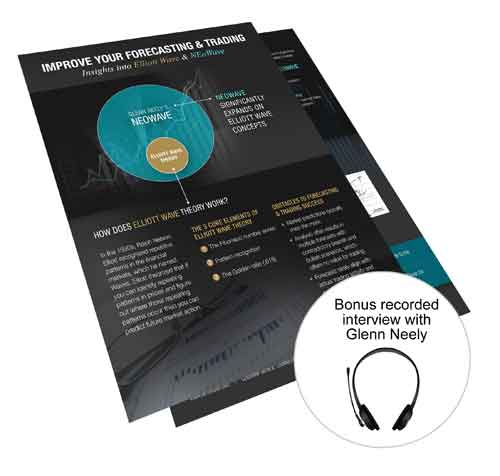NEoWave Blog
11/21/2019 - NEoWave Staff
Article #2 of 7: Elliott Wave analysis: Glenn Neely's tips for market selection, trend identification, timing & exit strategy
Introductory note: This is Part 2 of a 7-part series. In these articles, Glenn Neely, NEoWave founder and author of Mastering Elliott Wave, discusses Elliott Wave concepts from his unique point of view as a world-renowned Elliott Wave expert. In this frank, open, and insightful interview, Mr. Neely reveals his advanced forecasting and trading concepts – based on his decades of experience as the creator of NEoWave forecasting and his exciting Neely River Trading Technology, which fuels profitable trading results.
In the first article in this series, I introduced 3 critical phases to successful, professional trading. In Phase 1 – the forecasting, trend analysis, and stock selection phase – this is where Elliott Wave analysis can play a part. This is where you look at different markets, different charts, and maybe get a collection of 5 to 10 different market sectors. There are lots of different approaches you can take here. For example, you could look at all the different sectors of the U.S. such as utilities, real estate, fixed income, metals, industrial, financial. You could have one stock or one ETF in each one of those categories, perhaps about 20 different categories.
You would do your Elliott Wave analysis on all those markets. I recommend starting with a monthly timeframe and figuring out which markets have clear Wave structure and which ones don’t. Avoid the ones that don’t have clear Wave structure. For those that are clear, then you would consider taking trades in those particular markets.
Again, this is part of what I consider Phase 1 of the successful trading process. You would decide which markets you’re going to trade and in which direction you’re going to trade them. So it’s market or stock selection and trend identification. That’s Phase 1. Within that phase, you could say, for example, “Gold is in an up-trend and I want to go long, but it’s currently in a rally and I want to wait for a correction for a sell-off to get in. I want to get in at a better price, lower risk.”
So now you’re moving into Phase 2 (Timing), and you could even have Phase 2 as part of your Elliott Wave analysis process. Phase 2 would be deciding when you’re going to get into that particular position. So it’s a timing issue and that would require waiting for Wave 2 of a five-Wave move to finish, or Wave C of an ABC correction to finish, or Wave 4 of a five-Wave move to finish – something where you’re at the bottom before you start a nice advance again. So that would be the next step in the process.
Once you’re in the position, then it becomes a money management process and waiting to exit with conditions that justify getting out. If you’re going to use Elliott Wave analysis for the entire trading process (which I don’t anymore), then you would wait for Wave 5 to reach its conclusion and then start exiting that position.
Let’s say you bought Gold at $1000, and you think it’s going to $2000. But right after you got in, it drops to $900. So you’re starting to lose money on your position. You need to set specific parameters on how to manage that position from a profit-loss perspective, not necessarily a Wave theory perspective. If you get in and it’s going against you quite a bit, then it probably means your Wave count was wrong. So then what do you do?
Well, then it’s a matter of managing the risk properly. When I have an individual stock go against me about 10%, I look to get out of that position. As long as it doesn’t do that, if it’s 5% or less, then I would hang onto the position and keep waiting for it to move into my favor, waiting for the fifth Wave or the third Wave to get started, and reaching the target.
So those are some tips if you’re going to use Wave theory as your sole market selection, trend identification, timing, and exiting strategy. This would be the process that I would use.
Read the articles in this 7-part series:
Article #1,
Article #2,
Article #3,
Article #4,
Article #5,
Article #6,
Article #7
Get 2 educational tools FREE!
Get Real-World Advice for Better Forecasts and Trades for FREE! Sign Up Now!
Learn more about:
NEoWave Trading Service
NEoWave Forecasting Service
Mastering Elliott Wave by Glenn Neely
Follow us @NEoWaveTheory:
Twitter: https://twitter.com/NEoWaveTheory
Facebook: https://www.facebook.com/NEoWaveTheory


